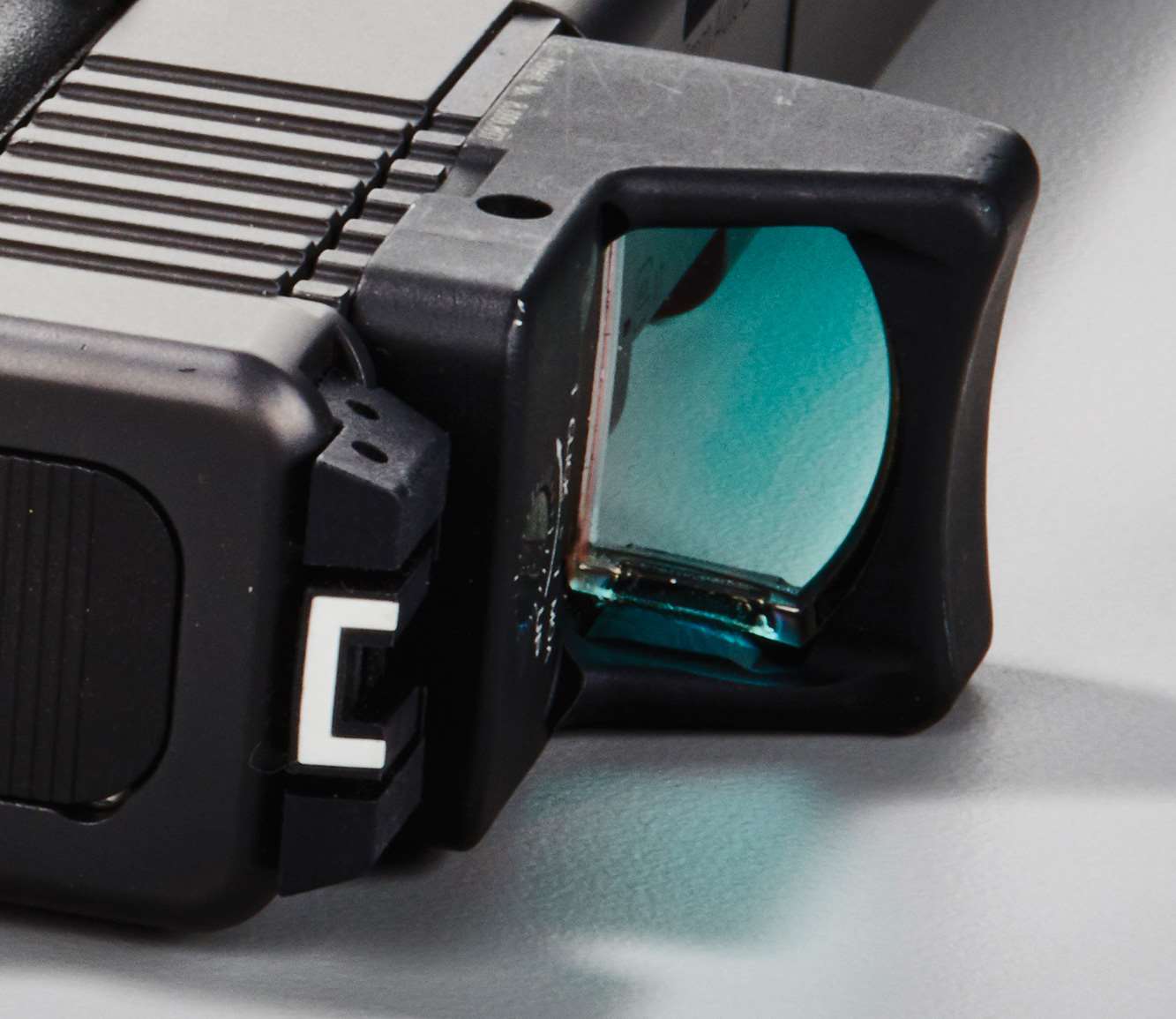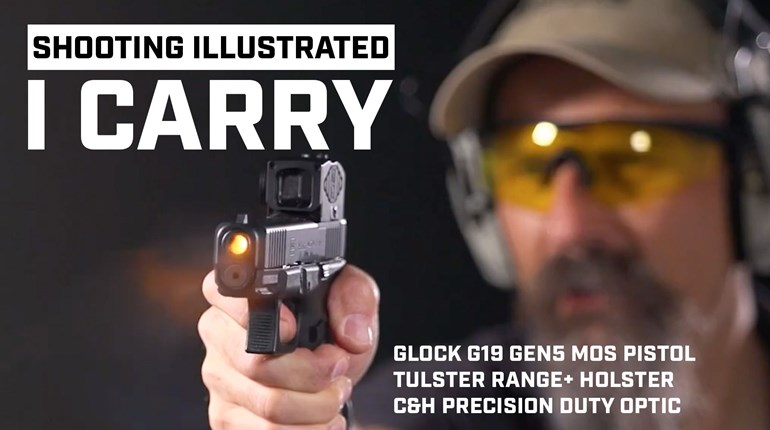
If it seems presumptuous to suggest that Glock pistols need no introduction, we would have to ask: To whom, precisely, do they need introducing? That Austrian olio of lightweight, super-tough polymer frame; Safe-Action trigger system; steel slide and barrel; and a grand total of only 34 parts is at least iconic. Even a cursory review of military/SOF, law enforcement and civilian applications would seem to leave little chance for unfamiliarity. And then there are those 30-plus years of proof that they are all but indestructible and marvelously reliable.
Yes, that Glock. Very well then, on to business.Very few cartridges can begin to do what the 10 mm does easily, and fewer pistols still can demonstrate that capacity like a long series of Glocks.
We start our look at the G40 with what our legal friends—assuming we have any—might call a “statement against interest,” that is, a concession: We are full-on 10 mm fans and always have been. Glock predecessors in the caliber are a mammoth part of “why.” Other 10 mm fans will understand: Unlike so many other handguns in the caliber that have come and gone, there are still a lot of early G20s out there—Glock’s original 10 mm.
Certainly this was a clever bit of market assessment back in 1991. With most other 10s failing to reach the market in any numbers at all (the Bren Ten of Sonny Crockett/Don Johnson/“Miami Vice” fame) or quickly deconstructing under the pressures of the early Norma loadings (many a sad Colt Delta Elite or Smith & Wesson 1006 owner still laments), there was plenty of elbow room on retail shelves, and ample cache. The latter came from the dean of practical/tactical pistol at the time, as well as conceptual father of the cartridge, Col. Jeff Cooper. “What the 9 mm won’t do at all,” Col. Cooper is said to have quipped, “the .45 will do at 25 yards, and the 10 mm at 75.”
The ballistics argued that he was correct, although the bullets and powders of the day did not allow the cartridge to truly shine. Down-powering to repair the perceived flaws—blowing up guns and punishing recoil—was, in fact, the genesis of a much better known cartridge—the .40 S&W. But with the arrival of the .40’s greater manageability, departed was the magnum-like power in an autoloader that was the appeal in the first place. It took patience and perseverance to remain a 10 mm fan, and except for Glock, the choices were limited.
That patience is now amply rewarded in the Glock G40.
As with its G20 forebear, the G40 remains a large pistol by any standard. It adds slide proportions (8.19 inches between the sights) reminiscent of the 17L (9 mm) and 24 (.40 S&W), though the long sight radius only now is matched with a cartridge that can take true advantage of it. As a Gen4, it also shares the handsome improvement in grip ergonomics—complete with optional backstraps and beavertails for those with bigger mitts. The net grip reduction in the base configuration also lets a surprising number of shooters back into the game: Several (willing!) volunteers told us the previous 10 mils were just too big, but that the G40 proved both comfortable and secure.

That “comfortable and secure” became a major fixture in our appraisal. In its original loadings, the 10 mm quite intentionally edged up on the .41 Magnum in terms of power. “Wallop” should come to mind. But in order to preserve the earlier pistols, 10 mm was rapidly and substantially down-powered by many ammunition manufacturers. Good news? These loads are soft-shooting delights in the G40.
Those energy levels persist today, and while still consequential for an autoloader, 400 to 460 ft.-lbs. (Federal’s 180-grain FMJ was a superb performer in this range, producing sub 1” 5-shot groups and very smooth cycling), the 10 mm as a cartridge with the G40 as a vehicle is capable of so much more. Fortunately, loads from Hornady, Corbon, Buffalo Bore and Double Tap are bringing back the option of cartridges at or near the original power levels.
We broke into our (now tiny) stash of genuine 170-grain JHP Norma to compare it with the contemporary loads of both power ranges. Our quantities were such that we shot it for both ballistic data and accuracy, although the latter is understandably compromised. Still, all five shots easily hit 8” plates at 50 yards (rested), and the chronograph data impressed: 1379 ft./sec, and 717 ft.-lbs. of energy. That’s not too bad for quarter-century-old ammunition and factory notch-and-post sights. New “full power” formulas courtesy of Corbon ranged from 560 ft.-lbs. (a 200-grain FP flying anvil) to 727 ft.-lbs. (135-grain JHP—a 1,558 ft./sec thunderbolt).
Several considerations emerged from our tests. Generous chambers in early Glocks helped establish a reputation for superb reliability, but were hard on brass (over-expansion). Original 10 mm power only magnified this effect, and particularly so where the case web/rim was over the integral feed ramp of the barrel. Asymmetric bulges were a dead giveaway of early Glock-fired brass as a result. This seemed perilously close to case rupture and worried some 10 mm fans—not wholly without reason.
Such bulging is long gone in less powerful calibers, and we could find no evidence of it in fired cases from our G40 either. Visual inspection and actual resizing in a reloading press never gave a hint of a bulge (even the full-power Norma cases looked fine, and resized with ease). Just the same, always inspect those cases carefully for pressure signs.
The second was shooting comfort: In a word, we found it astonishing, even with the full-power, original Norma and modern sequels. Granted, you’ll never mistake it for 9 mm, but for a cartridge that is up to black bear or deer with proper shot placement (check your state laws), the G40 renders 10 mm eminently controllable and merely authoritative with a proper grip and stance.
A third is perhaps slightly more arcane: The tremendously strong 10 mm case, wide variety of bullet weights and excellent accuracy (our Sierra manual called the 10 mm “an inherently accurate cartridge, routinely producing 10-shot groups of under one inch …”) makes the caliber attractive to handloaders. As a hunting handgun, or for long-range pistol shooting for other purposes, the G40 may (shortly) prove to have few equals. If you wish, you can shoot the new Glock in an entirely conventional way with the provided factory or aftermarket notch-and-post sights.
We’ve saved the best for last. Added to all the other Gen4 goodies, the G40 comes with a Modular Optics Slide, or MOS. If you wish, you can shoot the new Glock in an entirely conventional way with the provided factory or aftermarket (our friends at Hiviz, we know, have their litewave and tritium) notch-and-post sights. You will enjoy it.
But if your peepers aren’t what they used to be—certainly ours are not—you can now add a reflex or “red-dot” sight to your G40 in about 10 minutes. With the removal of a filler plate, a machined slot in the slide plus one of the four (wisely, conveniently provided) base plates allows for the mounting of nearly any micro reflex sight you can name. With such a sight, the 10 mm is at least a hundred-yard pistol, and an accurate one, too. Especially with lighter bullets in the potent loadings, zipping, accurate shots out to 100 yards were no problem.
Arguably in its fourth incarnation, the 10 mm has stubbornly clung to shooting life. Perhaps now it is clear why: Very few cartridges can begin to do what the 10 mm does easily, and fewer pistols still can demonstrate that capacity like a long series of Glocks. In the G40, the Austrian masterpiece reaches a new pinnacle of versatility and excellence.
MSRP for the Glock G40 is $699. Visit Glock at https://us.glock.com.
Nuts and Bolts
If you aren’t familiar with red dot sights, you’ll want to be: the optical principles on which they are based provide for both a clear aiming point and a clear image of the target. This is an understandably big deal if 20/20 is a fond memory. Simply, they allow your distance prescription (whether by eyeglasses, contacts or surgery) to present a clear target image, and then lay a precise dot–representing the impact point of the shot–on the target. Because it isn’t a designation technology like a laser, it does not “compete” with sunlight, the dot will always seem bright in a good-quality sight. Furthermore, the dot doesn’t require visual centering. If the dot is on your intended target, the bullet will strike at that location (if all else goes well) even if the dot itself appears substantially off-center within the window of the optic.
We chose the Trijicon RMR for our tests, though mounts are provided for a host of others: EOTech, Docter, Burris Fastfire and Leupold DeltaPoint to name but a few. This rugged little bugger is well known in military circles with good reason. Marvelously tough and possessed of battery life measured in years, our sample put an extremely precise 3.25 MOA dot at our disposal. It made 8-inch plates a cinch to 50 yards (unrested), and 12-inchers an over 50-percent affair at 100. Especially with the high velocities possible with bullets like Nosler’s excellent 135 grain JHP, or CorBon’s 135 grain factory load, you’ll want to stretch the legs on a G40.

































